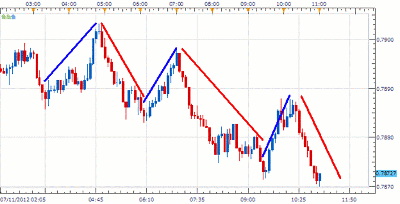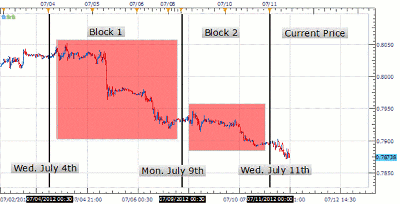Walker England of DailyFX.com explains how currency traders can spot and trade on short–term momentum spikes in the forex market.
One of the most important skills a scalper is required to learn is gauging short–term momentum. Before we even zoom onto a short–term graph, it is best to answer the following questions. What is my market bias? Will I be looking to buy or sell a particular currency pair?
Take the five–minute EUR/GBP graph below. Would you be a buyer or a seller here? It is hard to tell with such a limited amount of data at our immediate disposal. To help identify trading opportunities, it is often best to first scale out on a chart and begins by looking at a broader range of price action.
Prior to scalping on shorter–term charts, I recommend a form of multi–timeframe analysis to find market direction. Pictured below, we have a 30–minute EUR/GBP graph depicting approximately a week’s worth of price action. This graph has been segmented into trading blocks by identifying the previous Mondays and Wednesdays.
Drawing a Building Block on Market Scope 2.0 is relatively straightforward by using the vertical line function under the insert menu. Just cut and paste the lines on the appropriate dates, and you can then begin your analysis.
The purpose of this methodology is to fragment our analysis and ensure that price is heading in a continuous trending direction. If a block is printing higher lows and lower lows, it will be colored red, indicating a downtrend. If price is making higher highs and higher lows, it should be colored blue, indicating an uptrend. A yellow block is reserved for an indecisive market, printing both a higher high and a lower low during one price block.
The strongest trends have both Block 1 and Block 2 moving in the same direction. If the trend is unclear and our blocks are colored differently, it is time to move on to a new chart for scalping during the current price period.
So how would one begin to analyze the blocks placed on the EUR/GBP chart above? The analysis for Block 1 below begins on July 4. During this time, the EUR/GBP printed a high of .8055.
From the Block 1 high, price steadily declined, dropping as many as 134 pips to .7921. This block has been colored red, indicating that price for this period created a lower low with no new higher high being formed.
The strongest trends have both Building Blocks trending in the same direction. As we can see above, Block 2 has also been colored red, indicating a continued downtrend. From July 9 through July 11, price printed a lower low at .7894 without creating a higher high. With this analysis completed, we now know that we should only be looking to sell the EUR/GBP with the scalping strategy of our choice.
Traders will look for momentum to carry through Monday, at which point a new block will be formed and our analysis will begin again.
Walker England is a trading instructor for DailyFX.com.























